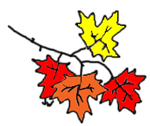What’s the Difference between Deciduous, Coniferous, and Evergreen trees?
There’s another way of telling the difference between the types of trees, and that’s by their leaves or needles.
 Deciduous (de-sid-you-us) trees usually have green leaves that change colour in the fall to bright red, orange or yellow. The leaves fall off for the winter, but the tree isn’t dead – the leaves all grow back again in the spring. Most deciduous trees are hardwood, and young deciduous trees tend to grow faster than evergreen trees. Oak trees, fruit and nut trees, and maple trees are all deciduous.
Deciduous (de-sid-you-us) trees usually have green leaves that change colour in the fall to bright red, orange or yellow. The leaves fall off for the winter, but the tree isn’t dead – the leaves all grow back again in the spring. Most deciduous trees are hardwood, and young deciduous trees tend to grow faster than evergreen trees. Oak trees, fruit and nut trees, and maple trees are all deciduous.
The opposite of deciduous trees are evergreens. Instead of leaves, evergreens usually have darker green shoots or spiky needles. Sometimes the shoots or needles fall, but a new one grows right back in its place. That makes these trees stay green all year round, even in the winter! Many evergreen trees are coniferous (cone-if-er-us), which are trees that grow cones.
(A pine tree grows pinecones, so it is a coniferous tree.) Most coniferous and evergreen trees are softwood.
Some evergreen trees are very important for making paper, like spruces, pines, firs, and hemlocks. But, compared to deciduous trees, these trees take a longer time to grow big enough to cut down. That means that the trees we use to make paper take longer to grow back! That’s why we have to be careful how and when we use paper.
What’s the Difference between a Softwood and Hardwood tree?
We use the words “softwood” and “hardwood” to describe two different types of trees. Surprisingly, these terms don’t tell us so much about how hard or soft the wood is, but more about the species of the tree!
 When a tree is “hardwood,” it means that it grows flowers, like the cherry blossom tree. Hardwood trees have broad leaves (like the maple tree), and are usually deciduous. Its seeds have some kind of covering – an apple tree hides its seeds in an apple, and an oak tree hides its seeds in an acorn.
When a tree is “hardwood,” it means that it grows flowers, like the cherry blossom tree. Hardwood trees have broad leaves (like the maple tree), and are usually deciduous. Its seeds have some kind of covering – an apple tree hides its seeds in an apple, and an oak tree hides its seeds in an acorn.
So when a tree is “softwood,” that means it is coniferous. Instead of growing flowers, it grows cones, like the pine tree! And instead of broad leaves, it usually grows needles on its branches. Its seeds have no covering, and just fall to the ground to grow a new tree. (You might think that a cone, like a pinecone, counts as a covering, but when cones grow older they release the seeds which blow away in the wind, so pines count as softwood trees.)
The terms “softwood” and “hardwood” aren’t complete nonsense though – softwoods tend have softer wood than hardwoods, but it just isn’t always true.
